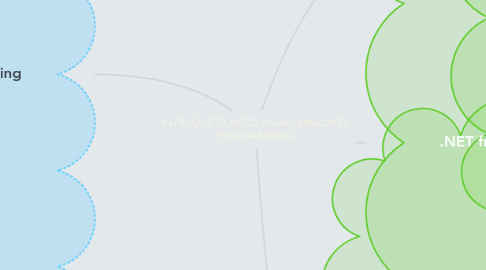
1. Event-Driven Programming
1.1. Definition :
1.1.1. Computer programming paradigm where the flow and control of the program are determined by some events.
1.2. Some event are some user action to sensor output , messages and thread such as :
1.2.1. 1.mouse clicking
1.2.2. 2.pressing key
1.2.3. 3.hovering mouse
1.3. Most Basic Event In VB.Net
1.3.1. 1.Click Event
1.3.2. 2.Load Event
1.3.3. 3.Double Click Event
1.3.4. 4.Key Press Event
1.3.5. 5.Mouse Move Event
1.4. Event Loop
1.4.1. 1.User Interact with page
1.4.2. 2.An 'event' is triggered
1.4.3. 3.A code handler runs in response
1.4.4. 4.The pages appearance is updated / modified as a result
1.5. Toolbox window
1.5.1. Display tools that could use with the current action document.
1.5.1.1. Exp : Control and compenent
1.6. Properties window
1.6.1. Allow to view and modify the properties of the form and of the control that it contains.
1.7. Solution Explorer
1.7.1. Manage the files associated with the current solution
1.8. Window Form Designer
1.8.1. Allows the design forms for typical windows application
1.9. Visual Basic Code Editor
1.9.1. To write a code that respond to control event
2. Discover the .NET framework
2.1. Overview
2.1.1. a software development framework from Microsoft
2.1.2. can be developed, installed and executed on Windows-based operating systems
2.2. Class Libarary
2.2.1. Framework Class Library (FCL
2.3. Programs written for .NET Framework
2.3.1. Common Language Runtime (CLR),
2.3.2. an application virtual machine that provides services such as security, memory management, and exception handling
2.4. object-oriented computer programming language implemented on the .NET Framework.
2.5. First Name
2.5.1. Beginner's All purpose Symbolic Instruction Code
2.5.2. Dartmouth College professors John Kemeny and Thomas Kurtz.
2.6. created by Microsoft in 1991
2.6.1. to make it a lot faster and easier to write
3. .NET framework elements
3.1. Common Language Runtime (CLR)
3.1.1. Provide an environment to run all the . net programs
3.2. .Net Framework Class Library
3.2.1. also called as Base Class Libarary
3.2.2. it is common for all types of applications
3.3. Windows Application
3.3.1. is the standard on most modern desktop and laptop PCs
3.4. Web Application
3.4.1. runs on a browser using a web server
3.4.2. a part of .Net platform and includes design time objects and contorls and a run-time execution context
4. Visual Basic .NET application types
4.1. Window Application
4.1.1. written to run under the Microsoft Windows operating system
4.2. Web Application
4.2.1. type of application that runs on a browser using a Web server configured with Microsoft Internet Information Services
4.3. Console Application
4.3.1. computer program designed to be used via a text-only computer interface, such as a text terminal
4.4. Window Service
4.4.1. application that usually serves a core operating system function running in the background and has no user interface.
4.5. Web Service
4.5.1. standardized way of integrating Web-based applications using the XML, SOAP, WSDL and UDDIopen standards over an Internet protocol backbone.
4.6. Component
4.6.1. reusable program building block that can be combined with other components in the same or other computers in a distributed network to form an application.

